The Edit Geometry rollout for Meshes contains most of the controls that let you alter the geometry of the mesh, at either the Object (top) level, or one of the sub-object levels.
Interface
The controls that this rollout displays can vary, depending on which level is active. If a control is not available for the active level, it might be grayed out or simply might not appear at all. The descriptions below indicate the levels at which controls are available.

[editing buttons]
- Create
- Lets you add sub-objects to a single selected mesh object. Select an object, choose a sub-object level, click Create, and then click to add sub-objects. Available only at the Vertex, Face, Polygon, and Element levels only.
For example, at the Vertex sub-object level, Create lets you add free-floating vertices to the object. The new vertices are placed on the active construction plane.
To create faces at the Face, Polygon, or Element level, click Create. All vertices in the object are highlighted, including isolated vertices left after deleting faces. Click three existing vertices in succession to define the shape of the new face. (The cursor changes to a cross when it is over a vertex that can legally be part of the face.)
You can also create new faces at the Polygon and Element sub-object levels. At the Face and Element sub-object levels, a new face is created after every third click. At the Polygon sub-object level, you can continue clicking as many times as you like to add vertices to the new polygon. To finish drawing a new polygon, click twice, or click again on any existing vertex in the current polygon.
At the Face, Polygon, and Element levels, you can add vertices while Create is on by
 +clicking in an empty space; these vertices are incorporated into the face or polygon you're creating.
+clicking in an empty space; these vertices are incorporated into the face or polygon you're creating. You can start creating faces or polygons in any viewport, but all subsequent clicks must take place in the same viewport.
Tip: For best results, click vertices in counterclockwise (preferred) or clockwise order. If you use clockwise order, the new polygon will be facing away from you, and you won’t be able to see it unless you’ve turned on Force 2-Sided or are using a two-sided material. - Delete (sub-object levels only)
- Deletes selected sub-objects and any faces attached to them.
- Attach
- Lets you attach another object in the scene to the selected mesh. You can attach any type of object, including splines, patch objects, and NURBS surfaces. Attaching a non-mesh object converts it to a mesh. Click the object you want to attach to the currently selected mesh object.
When you attach an object, the materials of the two objects are combined in the following way:
- If the object being attached does not have a material assigned, it inherits the material of the object it is being attached to.

Handle inherits material from the cup it is being attached to.
- Likewise, if the object you're attaching to doesn't have a material, it inherits the material of the object being attached.
- If both objects have materials, the resulting new material is a multi/sub-object material that encompasses the input materials. A dialog appears offering three methods of combining the objects' materials and material IDs. For more information, see Attach Options Dialog.
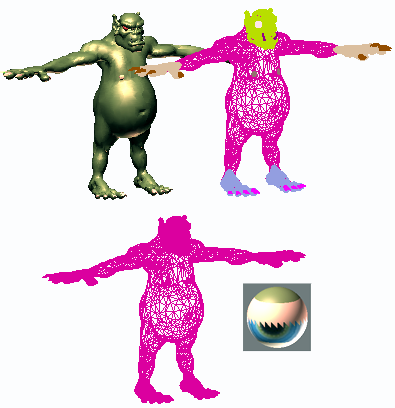
Upper left: Shaded view of model
Upper right: Wireframe view of model
Lower left: Model with objects attached
Lower right: Subsequent multi/sub-object material
Attach remains active in all sub-object levels, but always applies to objects.
- If the object being attached does not have a material assigned, it inherits the material of the object it is being attached to.
- Attach List (Object level only)
- Lets you attach other objects in the scene to the selected mesh. Click to open the Attach List dialog, which works like Select From Scene to let you choose multiple objects to attach.
- Detach (Vertex and Face/Polygon/Element levels only)
- Detaches the selected sub-object as a separate object or element. All faces attached to the sub-object are detached as well.
A dialog appears, prompting you to enter a name for the new object. The dialog has a Detach As Clone option that copies the faces rather than moving them.
Detached faces leave a hole in the original object when you move them to a new position.
- Break (Vertex level only)
- Creates a new vertex for each face attached to selected vertices, allowing the face corners to be moved away from each other where they were once joined at the original vertex. If a vertex is isolated or used by only one face, it is unaffected.
- Turn (Edge level only)
- Rotates the edge within its bounding. All mesh objects in 3ds Max are composed of triangular faces, but by default, most polygons are depicted as quadrilaterals, with a hidden edge dividing each quad into two triangles. Turn lets you change the direction in which the hidden edge (or any other) runs, thus affecting how the shape changes when you transform sub-objects directly, or indirectly with a modifier.
- Divide (Face/Polygon/Element levels only)
- Subdivides faces into three smaller faces. This function applies to faces even if you're at the Polygon or Element sub-object level. Click Divide, and then select a face to be divided. Each face is subdivided where you click it. You can click as many faces as you want divided, in sequence. To stop dividing, click Divide again to turn it off, or right-click.
[Extrude, Chamfer, and Bevel group]

These controls let you extrude edges and faces, chamfer vertices and edges, and bevel faces. Edge extrusion works in a fashion similar to face extrusion. You can apply these tools interactively (by dragging on sub-objects) or numerically (using spinners).
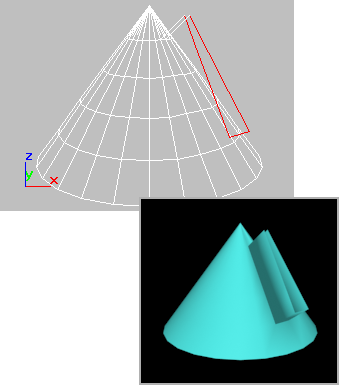
Extruded edges seen in viewport and rendered image
- Extrude (Edge and Face/Polygon/Element levels only)
- Click this button and then either drag to extrude the selected edges or faces, or adjust the Extrude spinner to perform the extrusion. You can select different sub-objects to extrude while Extrude is active.
- Extrude Amount This spinner (to the right of the Extrude button) lets you specify the amount to extrude the edge. Select one or more edges, and then adjust the spinner.
The Chamfer controls are available only at the Vertex and Edge sub-object levels. They let you bevel object corners using a chamfer function. You can apply this effect interactively (by dragging vertices) or numerically (using the Chamfer spinner).
- Chamfer (Vertex and Edge levels only)
- Click this button, and then drag vertices or edges in the active object. The Chamfer Amount spinner updates to indicate the chamfer amount as you drag.
If you drag one or more selected vertices or edges, all selected sub-objects are chamfered identically. If you drag an unselected vertex or edge, any selected sub-objects are first deselected.
A chamfer "chops off" the selected sub-objects, creating a new face connecting new points on all visible edges leading to the original sub-object. Chamfer Amount specifies the exact distance from the original vertex along each of these edges. New chamfer faces are created with the material ID of one of the neighboring faces (picked at random) and a smoothing group that is an intersection of all neighboring smoothing groups.
For example, if you chamfer one corner of a box, the single corner vertex is replaced by three vertices moving along the three visible edges that lead to the corner. 3ds Max rearranges and splits the adjacent faces to use these three new vertices, and creates a new triangle at the corner.
- Chamfer Amount Adjust this spinner (to the right of the Chamfer button) to apply a chamfer effect to selected vertices.
- Normal (Edge and Face/Polygon/Element levels only) Determines how a selection of more than one edge is extruded. With Normal set to Group (the default), extrusion takes place along the averaged normal of each continuous group (line) of edges. If you extrude multiples of such groups, each group moves along its own averaged normal. If you set Normal to Local, extrusion takes place along each selected edge's normal.
Beveling, available only at the Face/Polygon/Element levels, is a second step to extrusion: it lets you scale the faces you have just extruded.
Tip: A similar operation is Inset, which Editable Poly has but Editable Mesh doesn't. When you inset a polygon, you create another, smaller polygon of the same proportions inside the borders of an original polygon, in the plane of the original. Essentially, it's a bevel with no height. You can achieve this in Editable Mesh with the following procedure:- Select the polygon to inset.
- Right-click the spinner all the way to the right of the Extrude button. This performs an extrusion with no height, thus creating a new polygon plus connecting polygons in the same position as the original.
- Set a negative Bevel value using the numeric field or the spinner. This insets the new polygon created by the extrusion without changing its height.
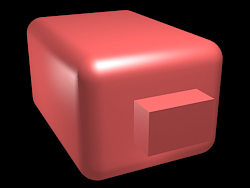
Chamfer box showing extruded face

Extruded face beveled in two different directions
You can bevel faces by dragging or by using keyboard/spinner entry.
- Bevel (Face/Polygon/Element levels only)
- Click this button, and then drag vertically on any face to extrude it. Release the mouse button and move the mouse vertically to bevel the extrusion. Click to finish.
- When over a selected face, the mouse cursor changes to a Bevel cursor.
- With multiple faces selected, dragging on any one bevels all selected faces equally.
- You can drag other faces in turn to bevel them while the Bevel button is active. Click Bevel again or right-click to end the operation.
- Outlining
- This spinner (to the right of the Bevel button) lets you scale selected faces bigger or smaller, depending on whether the value is positive or negative. It is normally used after an extrusion for beveling the extruded faces.
[Cut and Slice group]
Lets you subdivide edges with cut and slice tools to create new vertices, edges, and faces. For details, see Cut and Slice (Editable Mesh).
Weld group (Vertex level only)
- Selected
- Welds selected vertices that fall within the tolerance specified in the Weld Threshold spinner (to the button's right). All line segments become connected to the resulting single vertex.
- Target
- Enters weld mode, which allows you to select vertices and move them around. While moving, the cursor changes to the Move cursor as usual, but when you position the cursor over an unselected vertex the cursor changes to a + cursor. Release the mouse at that point to weld all selected vertices to the target vertex they were dropped on.
The pixels spinner to the right of the Target button sets the maximum distance in screen pixels between the mouse cursor and the target vertex.
[Tessellate group (Face/Polygon/Element levels only)]
Use these controls to tessellate (subdivide) selected faces. Tessellation is useful for increasing local mesh density while modeling. You can subdivide any selection of faces. Two tessellation methods are available: Edge and Face-Center.
- Tessellate
- Click to tessellate selected faces, based on the Edge, Face-Center, and Tension (spinner) settings.
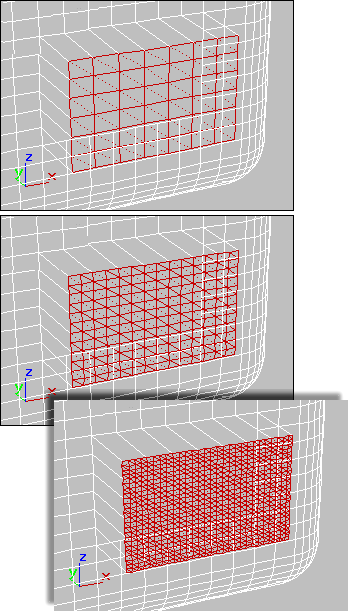
Top: Original selection
Middle: Tessellated once
Bottom: Tessellated twice
- Tension
- (Active only when Tessellate by Edge is active.) This spinner, to the right of the Tessellate button, lets you increase or decrease the Edge tension value. A negative value pulls vertices inward from their plane, resulting in a concave effect. A positive value pulls vertices outward from their plane, resulting in a rounding effect.
- By Edge/Face-Center
- Edge inserts vertices in the middle of each edge and draws three lines connecting those vertices. As a result, four faces are created out of one face. (To see this at the Polygon or Element sub-object level, turn off Display panel
 Display Properties rollout
Display Properties rollout  Edges Only.)
Edges Only.) Face-Center adds a vertex to the center of each face and draws three connecting lines from that vertex to the three original vertices. As a result, three faces are created out of one face.
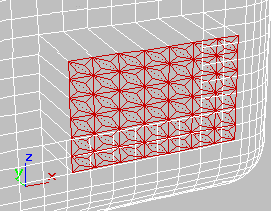
Set of polygons showing Face-Center tessellation
[Explode group (Object and Face/Polygon/Element levels only)]

- Explode
- Breaks up the current object into multiple elements or objects based on the angles of its edges. This function is available in Object mode as well as all sub-object levels except Vertex and Edge.
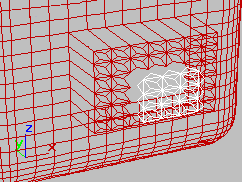
Exploded faces (white) removed from tessellated faces
The angle threshold spinner, to the right of the Explode button, lets you specify the angle between faces below which separation will not occur. For example, all sides of a box are at 90-degree angles to each other. If you set the spinner to 90 or above, exploding the box changes nothing. However, at any setting below 90, the sides all become separate objects or elements.
- To Objects/Elements
- Specifies whether the exploded faces become the separate objects or elements of the current object.
- Remove Isolated Vertices
- Deletes all isolated vertices in the object regardless of the current selection.
- Select Open Edges (Edge level only)
- Selects all edges with only one face. In most objects, this shows you where missing faces exist.
- Create Shape from Edges (Edge level only)
- After selecting one or more edges, click this button to create a spline shape from the selected edges. A Create Shape dialog appears, letting you name the shape, set it to Smooth or Linear, and ignore hidden edges. The new shape's pivot is placed at the center of the mesh object.
- View Align
- Aligns all vertices in selected objects or sub-objects to the plane of the active viewport. If a sub-object level is active, this function affects only selected vertices or those belonging to selected sub-objects.
In the case of orthographic viewports, using View Align has the same effect as aligning to the construction grid when the home grid is active. When aligning to a perspective viewport (including camera and light views), the vertices are reoriented to be aligned to a plane that is parallel to the camera’s viewing plane. This plane is perpendicular to the view direction that is closest to the vertices’ average position.
- Grid Align
- Aligns all vertices in selected objects or sub-objects to the plane of the current view. If a sub-object level is active, function aligns only selected sub-objects.
This function aligns the selected vertices to the current construction plane. The current plane is specified by the active viewport in the case of the home grid. When using a grid object, the current plane is the active grid object.
- Make Planar (sub-object levels only)
- Forces all selected sub-objects to become coplanar. The plane's normal is the average surface normal of all faces attached to the selected sub-objects.
- Collapse (sub-object levels only)
- Collapses selected sub-objects into an averaged vertex.